Yes, your parakeets definitely need foraging toys! These toys mimic natural behaviors, keeping your birds mentally engaged and reducing boredom. They provide a productive outlet for energy, promote physical exercise, and can even prevent obesity. By stimulating problem-solving skills, foraging toys help curb issues like feather plucking and excessive screeching. You can choose from a variety of toys, including homemade options or commercial puzzle feeders. Rotate toys regularly and verify they're made from safe materials. If you're curious about more strategies for enriching your parakeet's environment, there's plenty more to explore!
Key Takeaways
- Foraging toys mimic natural behaviors, promoting mental health and reducing boredom in parakeets.
- These toys provide mental and physical exercise, helping prevent obesity and related health issues.
- Engaging with foraging toys enhances problem-solving skills and encourages exploration, benefiting overall well-being.
- Regularly rotating toys and treats keeps parakeets interested and prevents habituation to their environment.
- Safe, durable materials are essential to ensure the toys are both engaging and safe for parakeets.
Importance of Foraging Toys
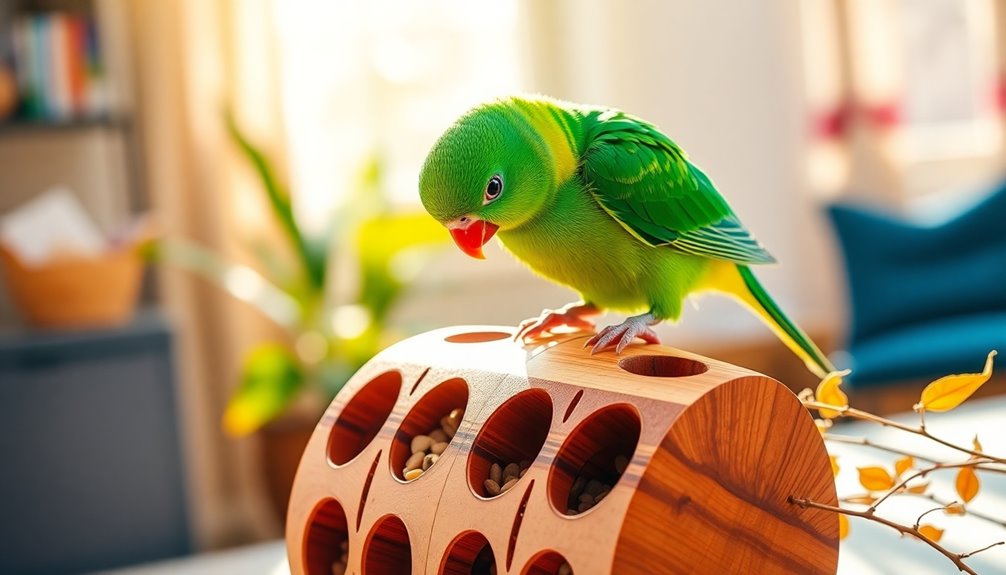
Foraging toys play an important role in your parakeet's well-being by mimicking their natural behaviors. These toys stimulate your bird's instinctual activities, which is essential for promoting overall mental health.
When you provide foraging toys, you effectively reduce boredom and anxiety, giving your parakeet a productive outlet for its energy. This engagement is significant, as it leads to both mental and physical exercise, helping to maintain your parakeet's physical health and prevent obesity.
Regular interaction with foraging toys also enhances your bird's problem-solving skills. As your parakeet learns to navigate these toys, it develops critical thinking abilities that keep its mind sharp.
Without these enriching activities, your feathered friend might face behavioral issues like feather plucking or excessive screeching, stemming from frustration and lack of stimulation.
Types of Foraging Toys
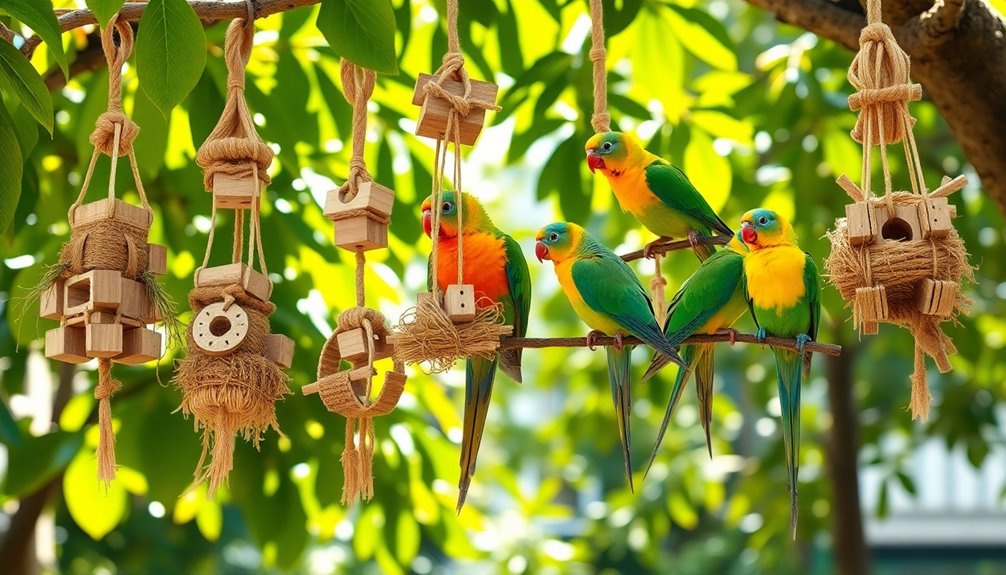
Offering a variety of foraging toys can keep your parakeet engaged and mentally stimulated. Foraging toys come in many forms, both homemade and commercial, tailored specifically for small birds like parakeets. You can easily create your own using unwaxed Dixie cups filled with treats, paper egg cartons, or wicker baskets for shredding and exploration. These options encourage natural behaviors while providing toys that require problem-solving.
Commercial foraging toys are also effective in keeping your bird busy. Look for simple treat dispensers, hanging toys, and foraging mats that encourage manipulation. Puzzle feeders are particularly beneficial, as they stimulate mental engagement and mimic the challenges your parakeet would face in the wild. Incorporating a variety of flavors in the treats can also enhance your parakeet's interest in foraging activities.
When choosing foraging toys, verify they're made from safe, non-toxic materials and are appropriately sized for your bird's beak strength.
Features to Consider
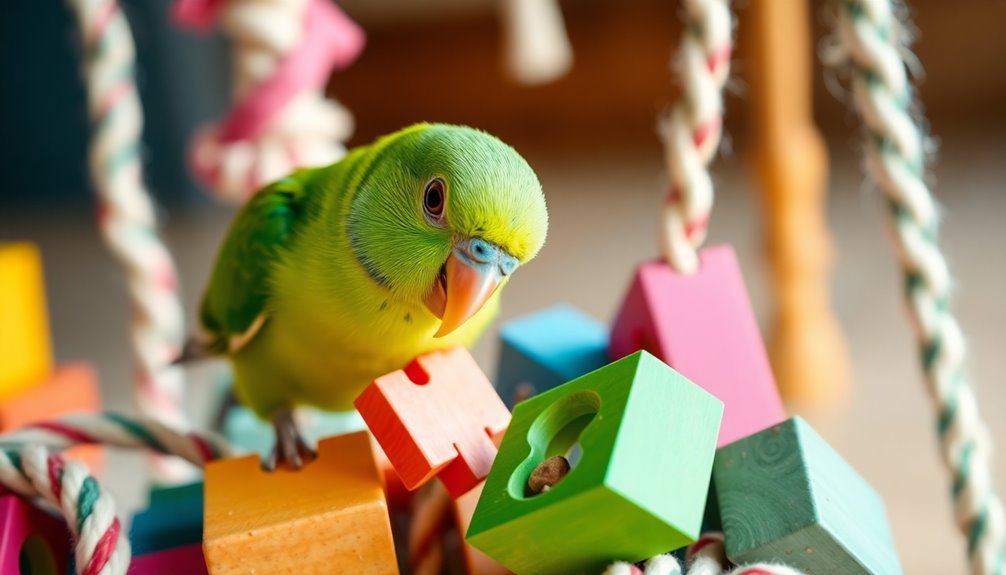
When selecting foraging toys for your parakeet, it's essential to take into account several key features that guarantee both safety and engagement.
First and foremost, make sure the toys are made from durable, non-toxic materials. Parakeets have strong beaks, and you want something that can withstand their playful nature while keeping them safe.
The size of the foraging toys is also important; they should be appropriately sized for your parakeet to manipulate easily and access hidden treats without risking injury.
Easy cleaning features are necessary too, as maintaining hygiene is key to your bird's health.
Incorporating a variety of textures in foraging toys can greatly enhance sensory engagement, stimulating your parakeet's natural curiosity and encouraging exploration.
Additionally, look for toys that promote problem-solving skills. Those requiring manipulation or disassembly can greatly enrich your parakeet's environment, leading to improved mental well-being.
Foraging Strategies for Parakeets
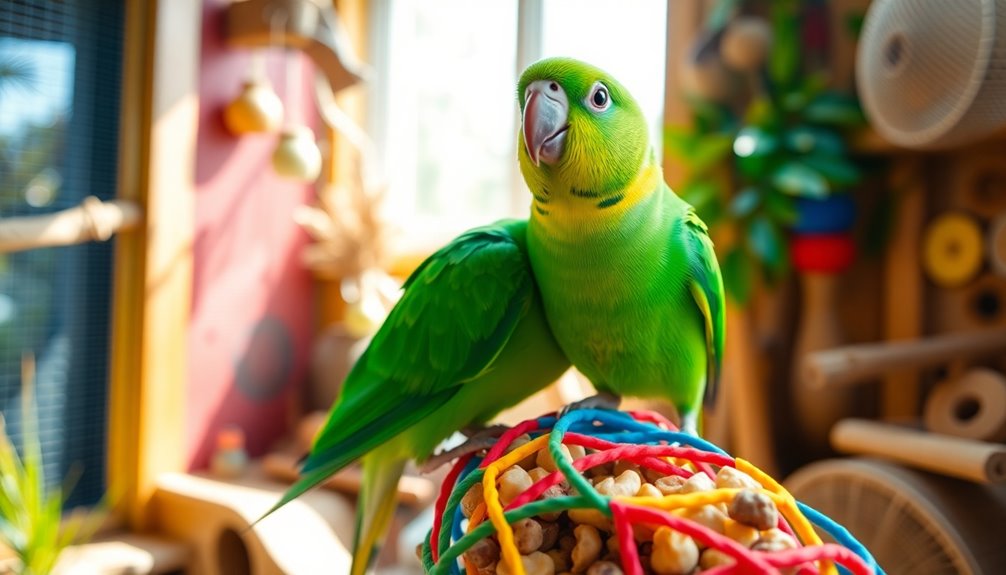
Parakeets thrive on mentally stimulating activities, and implementing effective foraging strategies can greatly enhance their well-being. Start by introducing foraging toys that mimic their natural instincts. Hiding treats in various locations within these toys encourages your parakeet to explore and problem-solve, which is essential for their mental health.
Opt for interactive foraging toys that require manipulation or disassembly. These toys not only challenge your bird but also promote physical exercise while stimulating their minds. Incorporating a variety of textures and materials keeps things interesting, preventing boredom and ensuring your parakeet stays engaged. Additionally, consider using essential oils that are safe for birds to create a more inviting environment around their play area.
To maintain the excitement, regularly rotate these foraging toys and change where you hide the treats. This prevents habituation and keeps your feathered friend enthusiastic to search for their next reward.
Maintenance Tips for Toys
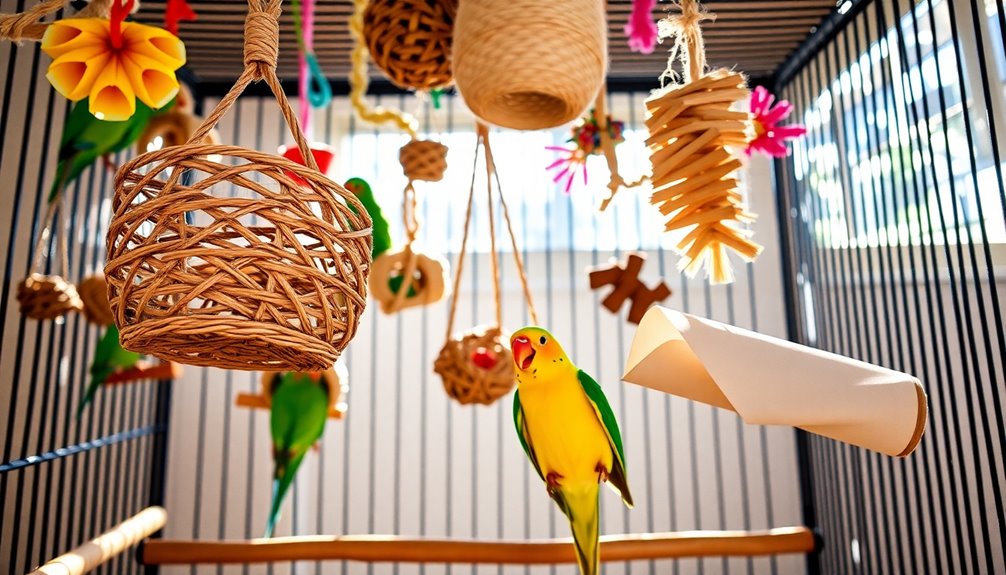
To keep your parakeet's toys safe and engaging, regularly inspect them for signs of wear and tear. This is vital to guarantee they remain safe and functional, preventing any potential injuries to your pet birds. When you notice any damage, it's time to replace or repair those toys.
You should also clean toys frequently using warm soapy water, making sure you rinse them thoroughly and allow them to air dry. This maintenance tip helps maintain hygiene and minimizes germ transmission, keeping your feathered friend healthy.
Don't forget to rotate the toys every week. This keeps your parakeet engaged and prevents boredom, encouraging exploration and play. By introducing new or different toys, you'll spark your bird's curiosity.
Choose materials that are easy to clean and disinfect, like plastic and metal, while avoiding those that might retain harmful residues, such as wood and cloth.
Finally, monitor interactions with the toys to see which ones are your parakeet's favorite toys. This insight allows you to adjust your toy selection for maximum enrichment, guaranteeing your parakeet stays happy and entertained!
Frequently Asked Questions
Do Parakeets Need Foraging Toys?
Parakeets definitely need foraging toys to thrive.
These toys stimulate their natural instincts and keep them mentally and physically active. Without them, your parakeet can become bored or anxious, leading to destructive behaviors.
By incorporating simple foraging options, like paper egg cartons or cups, you encourage your bird to explore and move around, mimicking their natural search for food.
It's a fun way to enhance their quality of life and happiness!
What Are Some Enrichment Ideas for Parakeets?
Think of your parakeet as a little explorer in a vast jungle of possibilities.
To enrich their environment, you can create foraging opportunities with simple DIY toys. Use empty toilet paper rolls stuffed with treats, or paper egg cartons filled with shredded paper.
Interactive toys like hanging baskets or puzzle feeders ignite their curiosity. Rotating these toys keeps their interest alive, ensuring your feathered friend stays mentally stimulated and engaged in their daily adventures.
Do Budgies Need to Forage?
Yes, budgies absolutely need to forage!
It's an instinctual behavior that keeps them mentally stimulated and happy. By encouraging this natural activity, you'll help reduce boredom and anxiety in your feathered friend.
Try hiding treats in paper egg cartons or small baskets filled with shredded paper.
Watching them solve the puzzle won't only engage their minds but also promote healthy behaviors, keeping your budgie active and content throughout the day.
What Toys Do Parakeets Like the Most?
Imagine your parakeet, Kiwi, excitedly pecking at a colorful hanging toy filled with treats.
You'll find that parakeets love toys that engage their senses and instincts. They particularly enjoy foraging cups and puzzle feeders, which challenge them while providing a reward.
Natural materials like untreated wood are favorites for chewing.
Rotate their toys regularly to keep things fresh and maintain their interest, ensuring Kiwi stays happy and entertained!
Conclusion
Incorporating foraging toys into your parakeet's environment isn't just fun; it's essential for their mental stimulation and overall well-being. For instance, when Sarah introduced a puzzle feeder to her parakeet, Kiwi, she noticed a remarkable increase in his activity and curiosity. He spent hours investigating and playing, which reduced his boredom and improved his mood. So, don't wait—enhance your feathered friend's life with foraging toys, and watch them thrive!










